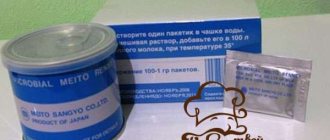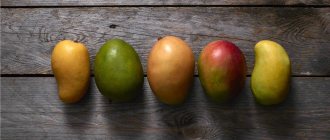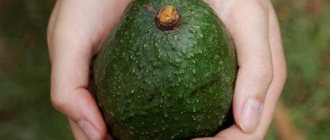Mango taste captivates with its sweetness and “explosion of exoticism”. But in order for it to reveal itself in all its glory, mangoes must be stored correctly. There are several features you should know.
Ripe fruits spoil quickly. At room temperature, after 2–4 days the flesh darkens and becomes cloying. Under no circumstances should unripe mangoes be kept in the refrigerator. Otherwise, they will remain tasteless, tough and unappetizing.
General recommendations
Mango is an exotic and beloved fruit by many, which is brought to us from warm countries, which is why it often does not have time to ripen and is sold green in stores. This is the main difficulty of storing it, which is why many are faced with the fact that it begins to deteriorate within a few days after purchase.
When storing fruit, follow the rules and tips:
- Average temperature. Regardless of the variety and degree of ripeness of mango, it is recommended to store it at a temperature of +8 to +16 degrees Celsius. Then all useful elements will be preserved in it, and it will not deteriorate.
- Not too high humidity. High air humidity can lead to rotting of the fruit, so this indicator should remain within 80-90%.
- No sudden temperature changes. The temperature in the place where the treats are stored must be stable.
- Avoid plastic bags and cling film. If you want to fold or wrap the fruit in something, use parchment paper or paper bags for this - they will preserve the freshness and benefits of the fruit.
Mangoes must be handled carefully - do not throw, crush or roll the fruit. The appearance of dents on an unripe fruit can lead to its premature spoilage and rotting.
How to choose
- You can determine the normal degree of ripeness of a mango by its aroma and sweet taste. The fruit should be round in shape with a smooth, elastic skin. If you gently press on the peel and release, it immediately returns to its original shape.
- It is better to buy fruits that are purchased for storage purposes slightly unripe. You can easily recognize them: they are harder and have a weak aroma.
- Regardless of whether the fruit is ripe or not, there should be no dark brown or gray spots on its surface, as well as dents or damage. The fruit pulp should have a uniform color corresponding to the degree of ripeness.
Storing unripe mangoes
Most often, the final ripening of mangoes at home occurs in 3-5 days, which depends on its initial condition.
When storing unripe mangoes, follow these tips:
- Do not store the fruit in the refrigerator. At low temperatures, the fruit will not be able to ripen and will gradually begin to deteriorate.
- Place the fruit in a paper bag or wrap it in parchment paper.
- Store the fruit in a warm, bright place. For example, you can simply leave it on the countertop for a couple of days or even put it on the windowsill - the sun's rays will speed up the ripening of the fruit.
- To speed up its ripening, add other fruits to it - bananas, apples, pears.
You can tell that a mango is ripe enough by touch. To do this, periodically check it for softness - as soon as, after pressing your finger on the peel, a small dent remains on it, the fruit can be considered ready to eat.
Once the fruit has ripened, it cannot be stored in a warm place. Place it in the refrigerator to avoid spoilage.
Tips for choosing
Before buying a mango in the supermarket, take the fruit in your hand and examine it carefully. Never buy the first fruit you come across or products on sale: there is a chance of running into a “delay.” Ripe fruit can always be distinguished by obvious signs:
- it has a pleasant subtle aroma emanating from the skin;
- When you press your fingers on the pulp, you feel elasticity. The fingers should not fall inside, but the flesh should not be hard;
- There should be no damage or cracks on the skin. The skin is uniform and smooth.
Many people mistakenly believe that a ripe mango should only have an orange color. This is not entirely true. The fruit can be yellow, green, red in color - its color depends on the variety.
On the shelves of Russian stores there are most often mangoes brought from India, China and Thailand.
Storing ripe mango
If the mango is already ripe, but you don’t want to eat it or use it for cooking, pay attention to its proper storage, which will help keep the fruit juicy and fresh longer.
There is no need to wash the fruit - this way it will be stored longer. Place the fruit in a paper bag or wrap it several times in parchment paper, and then put it on the bottom shelf of the refrigerator closer to the freezer - a lower temperature will increase shelf life. It is not recommended to leave fruit in the refrigerator door, since there it can begin to deteriorate faster due to unstable temperature conditions.
Make sure that there are no other strong-smelling foods near the mango (such as smoked fish) that it might pick up.
Check the fruit daily for softness so that it does not become too soft and crumbly, since overripe fruit can spoil in just a couple of days. Otherwise, you can store it in the refrigerator for up to 8-10 days.
We also invite you to watch a video that explains how to store mangoes:
How to store fresh fruits
Most often, housewives are interested in where to store mangoes that are well ripe. Such fruits can retain their freshness for a couple of days after purchase, remaining at a temperature of +15+25 degrees. If you do not plan to eat the fruit in the near future, it is better to put it in a dark, cool place or in the refrigerator. At the same time, you need to constantly ensure that individual specimens do not begin to become covered with dark spots and do not become too soft and loose. It is better to get rid of such fruits, as they have already begun to deteriorate.
Storing cut mango
It is more difficult to store cut mangoes, since pathogenic microflora quickly accumulates on the cut surface, which can lead to spoilage of the fruit.
Please note that if a mango is left at room temperature, it will begin to rot within a few hours, so it should be placed in the refrigerator immediately.
When storing cut fruit in the refrigerator, follow these rules:
- Place it in a container with an airtight lid - this will help prevent other odors from the refrigerator from penetrating into the mango. However, it is still worth making sure that there is no smoked fish.
- If you did not cut the fruit, but only cut it in half, leave the stone in part and store the rest of the product with it. This will help keep it fresh and juicy longer.
- It is recommended to place the container with fruit in the vegetable compartment or on the top shelf of the refrigerator so as not to overcool it. The refrigerator door should also not be used.
- Brush or sprinkle the cut fruit with lemon juice to prevent it from turning black and maintain its original appearance.
Mangoes also don't last long in the refrigerator - only about a day, so you shouldn't cut too large fruits if you know you won't have time to eat them.
What is the best way to store it?
To store mangoes, it is recommended to use any containers with hermetically sealed lids, since the aromatic fruit quickly spreads its smell throughout the refrigerator and absorbs surrounding odors.
Often, glass, enamel or plastic containers are used to store the fruit. The main thing is to wash them first and dry them thoroughly, since excess moisture can lead to rotting of the fruit.
How and where to store mangoes
It is impossible to say where it is better to keep mangoes at home. To decide on the method, you need to understand why you will need mangoes in the future:
- if the fruit needs to be preserved for several days, it can be placed in a pantry or refrigerator;
- When storage is intended to last for months, there is only one option left - the freezer.
- Heat treatment of the fruit - drying or cooking in granulated sugar - will help gain time (from 6 months to a year).
At room temperature
A temperature of 15-25 degrees is contraindicated for ripe mango if you are not going to eat it in the next two days. Such conditions are suitable for the fetus in a situation where it needs to be brought to maturity. Depending on the microclimate of the apartment, the fruit will ripen in 3-4 days. To prevent the fruit from spoiling during this time, do not forget about three rules:
- sun protection;
- regular checking of the fruit;
- consistently high humidity.
In a refrigerator
The shelf life of a mango in the refrigerator is determined by its ripeness. If you take fresh and ripe fruit, which fell into the hands of the buyer directly from the plane, then it can be left for 7 - 10 days. In supermarkets such cases are rare; for new supplies they turn to familiar small suppliers.
It is recommended to store mangoes and other fruits in a specialized “Freshness” compartment, which is equipped with modern refrigerators. If there is no such mode, then the fruits are placed on the middle shelf. To gain time, fruits are packed in paper. For wrapping, use food paper without ink.
If you buy unripe fruit in a chain store, it will quickly spoil in refrigerated conditions. There is no point in storing green fruits in the refrigerator. Over time, the mango will ripen, but will be unsweetened or completely tasteless.
Sliced mangoes are also stored in the refrigerator compartment. Reduced temperature extends shelf life. In addition to a favorable climate, additives are also used to slow down the process of product spoilage. Before storing cut mango at home, it is processed:
- ascorbic acid. Stir 250 mg of vitamin in a glass of water and cool. Lubricate the sections of the fruit with the mixture. The action of the antioxidant will prevent the pulp from quickly darkening.
- lemon juice. Treat the chopped pulp with concentrated lemon juice and place in the refrigerator. The juice acts in a similar way to ascorbic acid.
- sugar syrup. Dip the mango cubes immediately after cutting. The syrup layer will protect the pulp from contact with oxygen and allow you to gain time.
In the freezer
There is no clear answer to the question of whether it is possible to freeze mangoes. Keeping the fruit frozen is not the best idea, but it can be implemented. The problem is that at extremely low temperatures, the fruit loses its vitamins and fatty acids, not to mention its juiciness and aroma. Frozen mangoes can be stored for 3 months at a temperature of -18.
To freeze fruit correctly, you need to prepare in advance. For this:
- Peel the fruit and cut into pieces (in the form of cubes).
- Place the pieces on a saucer and cover with cling film on top.
- Place the saucer in the refrigerator for a couple of hours so that the slices get used to the lower temperature.
- Remove the plate and transfer the cubes to a bag. Tie the bag tightly and place it in the freezer for permanent storage.
There are strong mangoes that are not so easy to cut. To ensure this procedure goes smoothly, take a serrated knife and cut the fruit into three parts - vertically (from top to bottom). The result will be 2 pieces with the bulk of the pulp and a middle part with a bone. Then the parts are cut lengthwise and crosswise into 1*1 cm squares.
Freezing
If you managed to buy a lot of mangoes or you couldn't finish the already ripe fruits, you can resort to freezing them. This method will help preserve the integrity and aroma of the delicacy, but during long-term freezing there will be practically nothing left of the beneficial elements.
Here's how to freeze mangoes:
- Wash the fruit, cut in half and separate the pulp from the kernel.
- Cut the fruit into cubes, slices or other pieces that will be convenient for you to use in the future.
- Transfer the mango to a board lined with a plastic bag, and cover the pieces with another bag or parchment paper on top. Place the board in the freezer.
- After a day, remove the frozen product, package it in bags or plastic containers with a hermetically sealed lid and put it back in the freezer.
You can replace cellophane bags or plastic containers with vacuum bags, in which the fruit will also retain its taste and aroma.
It is recommended to place frozen mangoes in the compartment with vegetables, berries and fruits, in which other strong-smelling products are not stored.
Another option for storing mangoes in the freezer is in the form of a smoothie or puree. To do this, chop and beat the pulp in a blender, and then transfer it to plastic containers and put it in the freezer. This way the fruit will also retain its rich taste and aroma. To defrost puree, simply remove the container with it from the freezer and wait a few hours.
Mangoes are usually stored in the freezer for up to 3 months, after which they are frozen and are not recommended for consumption.
What are the benefits of mango?
In addition to its pleasant taste and aroma, mango is simply a storehouse of vitamins and microelements. In terms of ascorbic acid (vitamin C) content, ripe fruit is close to lemon juice. It contains provitamin A, vitamins E and D, B complex vitamins (B1, B2, B5, B6, B9), niacin (nicotinic acid, or PP, or vitamin B3). Mango has a very powerful antioxidant effect, accelerates tissue regeneration, strengthens the immune system and protects the body from bacteria and viruses. The pulp contains phosphorus, iron, manganese, zinc, calcium, and potassium.
It is not for nothing that in the homeland of mango - India - it is used in home medicine. The tasty fruit has a low calorie content - only 67 kcal per 100 g. Therefore, it is useful for those who want to lose weight. The abundance of fiber in the pulp also contributes to weight loss. One fruit contains 20% of the daily fiber requirement.
Mangoes have many other beneficial properties:
- fiber and enzymes support the functioning of the digestive system;
- a complex of vitamins and microelements improves the condition of hair, skin, nails;
- lutein, vitamin A, zeaxanthin have a beneficial effect on vision and eye health;
- the combination of potassium, magnesium and magniferin improves the condition of the heart and blood vessels;
- mango helps the body fight oxidative stress, which provokes the occurrence of cancer;
- it improves immunity and has anti-inflammatory properties;
- endorphins improve mood, relieve stress and activate brain activity.
Other ways to store mangoes
Since the freezing method is not suitable for everyone, and the fruit only lasts 7-10 days in the refrigerator, you can resort to one of the following methods for long-term mango storage:
Making confiture or jam from it
Fruit preservation
Drying
Making marmalade or marshmallows
Such methods of preparing various mango preparations will not preserve the benefits of the product, but will help preserve the rich smell and taste of the fruit, which is indistinguishable from store-bought alternatives.
You should resort to such options only if you do not know how to preserve already ripe mango, since it is better to eat it fresh.
Factors affecting the shelf life of mangoes
The ability of mango to retain beneficial properties and vitamins depends on the conditions of its maintenance and its initial condition. The shelf life of fresh fruits is quite long - about 1 month .
- Fresh ripe mangoes can be stored indoors for up to 5 days , but for longer storage they should be placed in a cooler, darker place where the humidity is 90-95% . The most suitable temperature for storing fruit is 10-13 degrees .
- Unripe and unripe fruits can be stored for up to 8 weeks . To speed up the process, it is recommended to wrap them in paper wrapper and place them in a warm place with approximately 90% .
- Sliced mango tends to spoil quickly, so to preserve the nutrients, it should be frozen , which will ensure that the mango can be stored for up to 10 months . Lemon juice, which should be sprinkled on the fruit, will also help extend the life of the cut pieces.
Storage errors
Premature spoilage of mangoes is associated with the following storage errors:
- Storing ripe mangoes with other fruits. They secrete special enzymes that can only accelerate ripening and reduce the shelf life of the fruit.
- Storing unripe mangoes in the refrigerator. By stopping the ripening process, you will not increase the shelf life of the fruit. This way it will spoil without even reaching a mature state.
- Storage in a plastic bag. Replace it with parchment paper to prevent the fruit from rotting.
- Storing pitted. If possible, leave the kernel in the fruit so it will last longer.
By following all the rules and recommendations for mango storage, you can not only avoid its premature spoilage, but also preserve all the valuable properties present in the fruit.
How to understand that the fruit has gone bad, and what to do in this case?
Yellow, green or red colors are typical indicators of a ripe, healthy mango, but they can be deceiving and misleading. What should you pay attention to if you suspect that fruit is overripe or spoiled?
- Healthy fruits look shiny . A white or grayish coating is a bad indicator, however, if there is only a little of it, you can simply peel it off or completely peel the mango. Healthy pulp without darkening or unpleasant odor can be eaten.
- You can also check the fruit by the thickness of the skin . You need to lightly press the surface of the fruit with your finger, and no dents or damage should appear in this place.
- It is not recommended to eat darkened or even blackened fruits to avoid poisoning.
- The smell of the fruit can also be an indicator that it has gone bad. Fruits suitable for consumption are accompanied by the smell of turpentine, but if the smell is suspicious, it is recommended to refuse to eat the fruit.
Unfortunately, it is no longer possible to preserve overripe mango, so the best option in this case would be to use it as an ingredient in the preparation of various dishes. Overripe mangoes can also be peeled, sliced and frozen for later use.
It should be noted that mango is a rather difficult fruit for the stomach and digestive tract. It is recommended to eat no more than 2-3 fruits , otherwise the digestive system may be upset, and colic or irritation of the gastrointestinal mucosa may occur.
Answers to popular questions
How do you know when a mango is ripe?
The ripeness of a mango is usually checked tactilely - to do this, you need to press on its skin and see if there is a dent left on it from your finger that will not recover. If it does appear, the mango is fully ripe.
Does it need to be washed before storing?
If you want your mango to last as long as possible, don't wash or cut it.
What to do if the mango has darkened?
Darkening of the pulp is its normal reaction to contact with oxygen, as a result of which the fruit begins to oxidize. This does not spoil the taste of the fruit, but only affects the appearance. To avoid such darkening, you can lubricate the cut with lemon juice before storing.
How long do unripe mangoes last?
At room temperature, mangoes ripen within 3-5 days, and then they can be stored for several more days. In the refrigerator, this time can double.
Can ripe mangoes be stored at room temperature?
No, it is better to store it in the refrigerator, otherwise it will begin to deteriorate within a day after such storage.
Shelf life of exotic fruit
The shelf life of mangoes depends on the degree of ripeness of the fruit. It is better to leave unripe fruits for several days at room temperature. Ripe fruits should be eaten immediately. In this case, it is better not to cut off the skin - too much juice will leak out. You can split the fruit in half, remove the pit and eat the pulp with a spoon. Ripe fruit can also be stored in the refrigerator, but no more than a week. Mango cut into pieces lasts the longest in the freezer - for several months.
Optimal storage conditions
When storing fresh mangoes, it is necessary to maintain the correct humidity and temperature conditions, as well as provide adequate lighting. Compliance with the conditions guarantees the preservation of all the valuable properties of the exotic fruit for a month.
See also
How much and where can sauerkraut be stored and how to choose the best place
Temperature
The optimal air temperature for unripe mango fruits is +13 °C, and for completely ripe ones it should not exceed +10 °C.
Illumination
Bright light is detrimental to mango fruits, so they must be stored in a securely protected place.
How to use when they are overripe
If you didn't eat your mangoes quickly enough and they became too ripe, don't throw them away. One of the best options for ripe mango is to cut it up and puree the fruit.
You can freeze the puree and use it in smoothies, desserts and other recipes. Use this when your mangoes are too soft to snack on!











